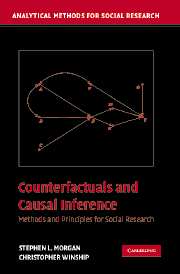Book contents
- Frontmatter
- Contents
- Acknowledgments
- Part 1 Counterfactual Causality and Empirical Research in the Social Sciences
- 1 Introduction
- 2 The Counterfactual Model
- Part 2 Estimating Causal Effects by Conditioning
- Part 3 Estimating Causal Effects When Simple Conditioning Is Ineffective
- Part 4 Conclusions
- References
- Index
2 - The Counterfactual Model
Published online by Cambridge University Press: 05 June 2012
- Frontmatter
- Contents
- Acknowledgments
- Part 1 Counterfactual Causality and Empirical Research in the Social Sciences
- 1 Introduction
- 2 The Counterfactual Model
- Part 2 Estimating Causal Effects by Conditioning
- Part 3 Estimating Causal Effects When Simple Conditioning Is Ineffective
- Part 4 Conclusions
- References
- Index
Summary
In this chapter, we introduce the foundational components of the counterfactual model of causality, which is also known as the potential outcome model. We first discuss causal states and the relationship between potential and observed outcome variables. Then we introduce average causal effects and discuss the assumption of causal effect stability, which is maintained in most applications of the counterfactual model. We conclude with a discussion of simple estimation techniques, in which we demonstrate the importance of considering the relationship between the potential outcomes and the process of causal exposure.
Causal States and Potential Outcomes
For a binary cause, the counterfactual framework presupposes the existence of two well-defined causal states to which all members of the population of interest could be exposed. These two states are usually labeled treatment and control. When a many-valued cause is analyzed, the convention is to refer to the alternative states as alternative treatments.
Consider the examples introduced in Section 1.3. Some of these examples have well-defined states, and others do not. The manpower training example is completely straightforward, and the two states are whether an individual is enrolled in a training program or not. The Catholic school example is similar. Here, the alternative states are “Catholic school” and “public school.” The only complication with these examples is the possibility of inherent differences across training programs and Catholic schools.
- Type
- Chapter
- Information
- Counterfactuals and Causal InferenceMethods and Principles for Social Research, pp. 31 - 58Publisher: Cambridge University PressPrint publication year: 2007



